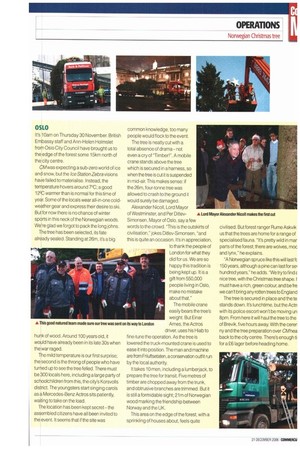OSLO
Page 69

If you've noticed an error in this article please click here to report it so we can fix it.
its 10am on Thursday 30 November. British Embassy staff and Ann-Helen Holmslet from Oslo City Council have brought us to the edge of the forest some 15km north of the city centre.
CMwas expecting a sub-zero world of ice and snow, but the Ice Station Zebra visions have failed to materiahse. Instead, the temperature hovers around 7-2C; a good 1 2C warmer than is normal for this time of year. Some of the locals wear all-in-one coldweather gear and express their desire to ski. But for now there is no chance of winter sports in this neck of the Norwegian woods. We're glad we forgot to pack the long johns.
The tree has been selected, its fate already sealed. Standing at 26m, it's a big hunk of wood. Around 100 years old, it would have already been in its late 30s when the war raged.
The mild temperature is our first surprise; the second is the throng of people who have turned up to see the tree felled. There must be 300 locals here, including a large party of schoolchildren from this, the city's Korsvolls district. The youngsters start singing carols as a Mercedes-Benz Actros sits patiently, waiting to take on the load.
The location has been kept secretthe assembled citizens have all been invited to the event. It seems that if the site was common knowledge, too many people would flock to the event.
The tree is neatly cut with a total absence of drama not even a cry of "Timber!". A mobile crane stands above the tree which is secured in a harness, so when the tree is cut it is suspended in mid-air. This makes sense: if the 26m, four-tonne tree was allowed to crash to the ground it would surely be damaged.
Alexander Nicoll, Lord Mayor of Westminster, and Per DitlevSimonsen, Mayor of Oslo, say a few words to the crowd. "This is the outskirts of civilisation," jokes Ditlev-Simonsen, "and this is quite an occasion. It's in appreciation, to thank the people of London for what they did for us. We are so happy this tradition is being kept up. It is a gift from 550,000 people living in Oslo, make no mistake about that."
The mobile crane easily bears the tree's weight. But Einar Ames, the Actros driver, uses his Hiab to fine-tune the operation. As the tree is lowered the truck-mounted crane is used to ease it into position. The man and machine are from Friluftsetaten, a conservation outfit run by the local authority.
It takes 10 men, including a lumberjack, to prepare the tree for transit. Five metres of timber are chopped away from the trunk, and obtrusive branches are trimmed. But it is still a formidable sight; 21m of Norwegian wood marking the friendship between Norway and the UK.
This area on the edge of the forest, with a sprinkling of houses about, feels quite
civilised. But forest ranger Rume Askvik us that the trees are home for a range of specialised fauna. "It's pretty wild in mar parts of the forest; there are wolves, moc and lynx," he explains.
"A Norwegian spruce like this will last fc 150 years, although a pine can last for se■ hundred years," he adds. "We try to find e nice tree, with the Christmas tree shape. I must have a rich, green colour, and be fre we can't bring any rotten trees to England The tree is secured in place and the te stands down. It's lunchtime, but the Act( with its police escort won't be moving un 8pm. From here it will haul the tree to the of Brevik, five hours away. With the ceren ny and the tree preparation over CMhea back to the city centre. There's enough ti for a E6 lager before heading home,
































































































































































































